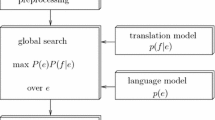Abstract
This paper describes experiments carried out utilizing a variety of machine-learning methods (the k-nearest neighborhood, decision list, maximum entropy, and support vector machine), and using six machine-translation (MT) systems available on the market for translating tense, aspect, and modality. We found that all these, including the simple string-matching-based k-nearest neighborhood used in a previous study, obtained higher accuracy rates than the MT systems currently available on the market. We also found that the support vector machine obtained the best accuracy rates (98.8%) of these methods. Finally, we analyzed errors against the machine-learning methods and commercially available MT systems and obtained error patterns that should be useful for making future improvements.



Similar content being viewed by others
Notes
The gold standard data were prepared by using system outputs and the gold standard was then biased using these system outputs. However, the bias was small because we used a tag in the corpus and also tense/aspect/modality expressions generated by three translators.
There might be a small number of cases where the tense/aspect/modality categories of a MT system are judged to be incorrect when a tense/aspect/modality selection inside the MT engine is correct but the generation module produces a wrong output string.
References
Cristianini, N., & Shawe-Taylor, J. (2000). An introduction to support vector machines and other kernel-based learning methods. Cambridge University Press.
Daelemans, W., Zavrel, J., van der Sloot, K., & van den Bosch, A. (1995). TiMBL: Tilburg Memory Based Learner version 3.0 Reference Guide. Technical report. ILK Technical Report-ILK 00-01 (http://www.ilk.kub.nl/ilk/papers/ilk0001.ps.gz).
Kudoh, T., & Matsumoto, Y. (2000). Use of support vector learning for chunk identification. In Proceedings of the 4th Conference on Computational Natural Language Learning and of the Second Learning Language in Logic Workshop (CoNLL-2000 and LLL-2000), in Lisbon, Portugal on September 13–14 (pp.142–144).
Murata, M., Ma, Q., Uchimoto, K., & Isahara, H. (1999). An example-based approach to Japanese-to-English translation of tense, aspect, and modality. In Proceedings of the 8th International Conference on Theoretical and Methodological Issues in Machine Translation (TMI-99), in Chester, England on August 23–25 (pp. 66–76).
Murata, M., Utiyama, M., Uchimoto, K., Ma, Q., & Isahara, H. (2005). Correction of errors in a verb modality corpus used for machine translation with a machine-learning method. ACM Transactions on Asian Language Information Processing, 4(1), 18–37.
Ristad, E. S. (1997). Maximum entropy modeling for natural language. Madrid: ACL/EACL Tutorial Program.
Shirai, S., Yokoo, A., & Bond, F. (1990). Generation of tense in newspaper translation. In Proceedings of 1990 Fall Institute of Electronics, Information and Communication Engineers (IEICE) Meeting, Vol. 6, D-69, in Hiroshima, Japan on October 1–4 (pp. 69) (in Japanese).
Weller, S. C., & Romney, A. K. (1990). Metric scaling: correspondence analysis (quantitative applications in the social sciences). SAGE Publications.
Yarowsky, D. (1994). Decision lists for lexical ambiguity resolution: application to accent restoration in Spanish and French. In Proceedings of the 32nd Annual Meeting of the Association for Computational Linguistics (ACL), in Las Cruces, New Mexico on June 27–30 (pp. 88–95).
Author information
Authors and Affiliations
Corresponding author
Rights and permissions
About this article
Cite this article
Murata, M., Ma, Q., Uchimoto, K. et al. Japanese-to-English translations of tense, aspect, and modality using machine-learning methods and comparison with machine-translation systems on market. Lang Resources & Evaluation 40, 233–242 (2006). https://doi.org/10.1007/s10579-007-9022-z
Received:
Accepted:
Published:
Issue Date:
DOI: https://doi.org/10.1007/s10579-007-9022-z




